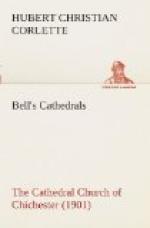tower we have already seen what was done, and obviously
it was one of the two towers that had fallen.
But what of the other of these? What suggestions
remain to show which it was? It is well known
that a central tower had been erected as part of the
original plan, and also that a new upper part was
being added to this same tower about the middle of
the thirteenth century. This new portion eventually
rose above the roofs to the level of the top of the
square parapet, about the base of the octagonal spire,
the spire being a still later addition. Now the
heightening of this tower—perhaps with
already the idea of a future spire in view—would
raise many questions. Experience would already
have taught the builders that the early central towers
of many other churches were incapable of carrying
their own weight. This being so, much less would
it do to suppose that it could bear the addition of
new weight upon the old piers; for though to all appearance
sound, the cores were of rough rubble work, not solidly
bedded and not properly bonded with the ashlar casing.
So the question arises, did they remove the whole
or part of the old central tower and piers, or were
they saved this trouble by the structure having shared
the fate of many others like itself, which fell, and
so made way for new work? Another tower had fallen
besides the one to which attention has already been
drawn; and as there appears to be nothing to show
that this other was the north-west tower, we must
see what evidence there is concerning the central
tower. That it was added to we already know.
But documentary as well as structural evidence comes
to our aid. The first is supplied by the records
of Bishop Neville’s episcopate; the next by the
researches of modern archaeology. Professor Willis
has shown in his remarks upon the structure of the
piers at the time of the collapse of the mediaeval
tower and spire in 1861, that these had not been rebuilt
at a date later than the twelfth century. But
Mr. Sharpe [6], writing to Professor Willis seven
years before the occurrence, indicates his discovery—from
a close examination of the structure then existing—that
before the upper part of the central tower was rebuilt
in the thirteenth century the earlier arches at the
crossing which were to support it had been taken down,
and probably a large part of the piers carrying them.
And that, though the twelfth-century voussoirs were
re-used others of a fine grained stone were inserted
among them to strengthen the arches, or as a substitute
for some of the rougher sandstones that could not
be used again. By this means, then, the original
form and detail of the twelfth-century arches was
preserved, so that the drawings representing the measured
studies of the building, which were Sir Gilbert Scott’s
principal authority upon which to base his restoration
of this portion of the tower, were made from work
which had already been once rebuilt. But why was
this part of the church rebuilt, and by whom?
Two alternative suggestions for the reason have been
offered.




